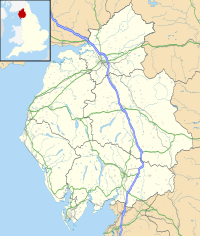Burneside Hall facts for kids
Quick facts for kids Burneside Hall |
|
|---|---|
| Cumbria, England | |

The ruined pele tower
|
|
| Coordinates | 54°21′23″N 2°45′25″W / 54.3563°N 2.7570°W |
| Type | Pele tower |
| Site information | |
| Owner | private |
| Open to the public |
No |
| Condition | Ruined |
Burneside Hall is an old building in Burneside, Cumbria, England. It was once a medieval pele tower, which was a strong, small castle built to protect people from attacks.
Contents
Discovering Burneside Hall's Past
Burneside Hall has a long and interesting history. Records show that a building stood here as early as 1290. At that time, a man named Gilbert Burneshead owned the land. He was an important local official, like a deputy sheriff, in the area called Westmorland.
How the Bellinghams Took Over
Later, a powerful family called the Bellinghams became the owners. This happened when Richard Bellingham married Gilbert Burneshead's daughter. This marriage brought the property into the Bellingham family.
Building the Hall's Strong Walls
The main parts of Burneside Hall that we see today were built in the late 1300s by the Bellingham family. The original hall had two pele towers. These towers were connected by a large, open room.
Only one of these towers is still standing. It is now mostly in ruins but is still three stories tall. This tower was used for storing food, like a pantry and buttery.
Changes Over the Centuries
In the late 1500s or 1600s, a two-story gatehouse was added to the front of the property. A very thick wall, called a barmkin, was also built around the hall. This wall was about 6 feet (2 meters) thick in some places.
During the 1600s, the big open hall was divided into smaller rooms. More windows were also added to the building. The second tower was rebuilt in the 1700s, but this process mostly destroyed its original shape.
What Old Wood Tells Us
Experts studied the wood in the hall in 2019. They found that some timbers were cut in 1422. Most of the wood used for the hall's roof was cut between 1579 and 1604. Other parts of the building used wood from the early 1600s. This helps us understand when different parts of the hall were built or changed.
Who Owned Burneside Hall?
The Bellingham family owned Burneside Hall for many years.
Losing and Regaining the Hall
In 1461, King Henry VI took Burneside Hall from Henry Bellingham. This happened because Henry Bellingham was accused of treason, which means being disloyal to the king. The Parr family then held the hall for a while. But Henry Bellingham got a pardon in 1480, and the hall was returned to his family.
New Owners and a Poet
In the 1530s, the Bellinghams sold Burneside Hall to Sir Thomas Clifford. From him, it went to John Fitzwilliam. In 1552, John Fitzwilliam sold it to John Machell, who was an important official in London.
After John Machell, the Braithwaite family bought the hall. They owned it for seven generations. In the early 1600s, a famous poet named Richard Brathwaite lived there.
Later Changes and Caretakers
In the late 1800s, Stephen Brunskill inherited the property. He worked to repair and restore some of the oldest parts of the hall.
Burneside Hall Today
Today, Burneside Hall is a very important historical site. It is listed as a Grade II* building and a scheduled monument. This means it is protected by law because of its special history and architecture.
In 2014, Historic England noted that the pele tower at Burneside Hall was slowly decaying. This means it was at risk of falling apart over time. The Hall is still part of a working farm today.


